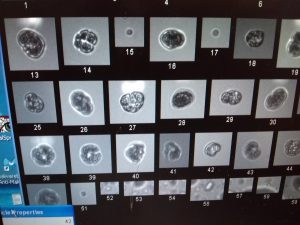
NOAA’s National Centers for Coastal Ocean Science has provided a HAB Event Response award of $28,000 to enhance a NOAA-led South Florida Ecosystems research cruise aboard the R/V Walton Smith to sample the ongoing red tide and ecosystem impacts on the Southwest Florida shelf. These cruises have been investigating coastal water quality in south Florida every other month since the late 1990s. From October 12-19, 2018 NOAA and its Florida partners will be assessing bloom conditions post-Hurricane Michael.
The objectives of the research cruise are
- to quantify the impact of the red tide on coastal water quality along the Florida Keys and Southwest Florida shelf,
- document the southern and offshore extent of the on-going red tide bloom,
- investigate bloom dynamics by quantifying Karenia brevis abundance and division,
- investigate ecosystem impacts of the bloom, and
- calibrate satellite measurements that will provide a time-series of the red tide impacts on south Florida coastal waters.
Samples will be collected around the Fort Myers, Sanibel, and Pine Island areas to measure cells and toxins to better understand changes in the severity, duration, and location of the ongoing red tide along the southwest coast of Florida. Key fish species will be collected and tested for brevetoxins to determine the impacts of the red tide on key fisheries species.
Blooms of the red tide alga, Karenia brevis, produce brevetoxins, which kill fish, turtles and marine mammals, and make shellfish dangerous to eat. The toxins can become airborne through wave action and may cause respiratory irritation for people on or near beaches. The current red tide originated offshore of Southwest Florida in October 2017. It intensified and moved closer to shore in June 2018, taking a toll on marine animals along Florida’s Southwest coast, including fish, sea turtles, birds, dolphins, and manatees, with multi-million dollar economic impacts to the shellfish and tourism industries. During September and October 2018, K. brevis algae were observed in patchy blooms along the Northwest, Southeast, and Atlantic Florida coasts.
Research cruise participants include coastal managers and scientists from NOAA’s Atlantic Oceanographic & Meteorological Laboratory (AOML), Southeast Fisheries Science Center, National Environmental Satellite, Data, and Information Service, and Florida Keys National Marine Sanctuary, and Florida’s Fish and Wildlife Research Institute (FWRI), Mote Marine Laboratory, and the University of South Florida.
The NCCOS HAB Event Response Program provides immediate assistance to help federal, state, and local officials manage events and advance the understanding of HABs as they occur. Read more about NCCOS participation in the ongoing Florida red tide response here.
For more information, contact Maggie Broadwater.
